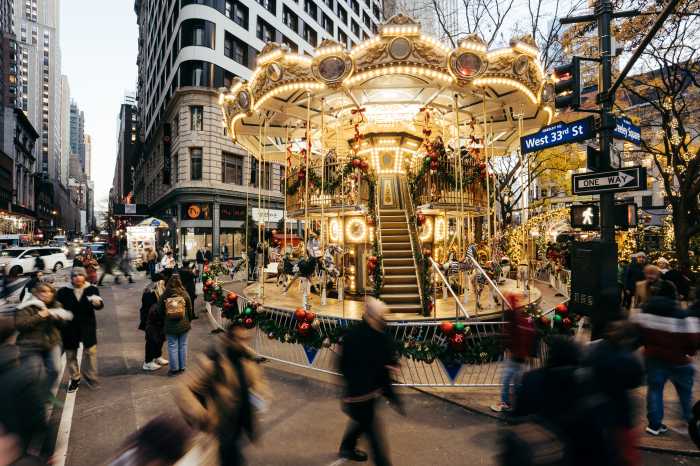
It’s no secret that the American Museum of Natural History is one of the most celebrated museums on the planet, making it without a doubt one of New York City’s most prized landmarks. Nestled on Manhattan’s Upper West Side, steps from Central Park, the Museum is home to 45 permanent exhibition halls, the Hayden Planetarium, and a library. The renowned institution–which occupies 1.6 million square feet and spans 27 interconnected buildings–boasts an extraordinary collection of over 32 million specimens of plants, animals, humans, fossils, rocks, minerals, meteorites, and cultural artifacts (only a small fraction of which is on display at any given time). Though there’s plenty to do at the Museum year-round, read on for a few insights on what’s currently hot to see and do at AMNH!
Pterosaurs: Flight in the Age of Dinosaurs
The newest addition to the Museum’s plethora of activities and showcases is “Pterosaurs: Flight in the Age of Dinosaurs,” a spectacular exhibition all about the reptiles that roamed the skies during the age of the dinosaurs. Kids and adults alike can marvel at over 150 species of pterosaurs, ranging in sizes from a tiny sparrow to a small airplane (one of the largest flying animals known to man, the long-necked Quetzalcoatlus has a wingspan of over 30 feet!). “Most people know pterodactyls, but what we’re trying to do with this exhibition is get the public to understand the immense range of these creatures,” says Roberto Lebron, the Museum’s senior director of communications.
The fossils in the exhibition are phenomenal, especially since pterosaur fossils are extremely rare finds. One particularly intriguing set of prehistoric remains is the “Dark Wing Fossil,” which is on view for the first time ever outside of Germany, its country of origin. The awe-inspiring display not only shows the dinosaur’s bones, but also its wing’s internal membrane, allowing viewers a magnificent glimpse at the structure of the pterosaur’s insides. The exhibit also includes a cool interactive feature called “Flying Like a Pterosaur,” which allows visitors to flap their “wings” and experience what it feels like to fly like one of the skyborne reptilians over a prehistoric landscape, with the help of motion-sensing technology.
Like what you see to the point that you wish you could take it all with you? Well, there’s an app for that. A handy “Pterosaurs” app that contains much of the exhibit’s contents is available for free download on AMNH’s website (indeed, many of the institution’s exhibitions have cool, companion interactive apps). “We’re trying to make exhibitions accessible to folks who can’t make the trip in, so they can somehow engage and experience them, too,” says Lebron. “[The apps] takes the museum experience outside of the museum.”
Mysteries of the Unseen World
Though it’s been showing IMAX films for quite some time, the Museum recently acquired the capability to show 3D movies too, making its cinematic experience that much sweeter. Now until the end of June, you can catch Mysteries of the Unseen World at the Museum’s LeFrak Theater: an exciting film that thrills its audience with an incredibly fascinating perspective of life on Earth, as it reveals organisms, processes, and phenomenons invisible to the naked eye. Thanks to time-lapse photography, nanotechnology, and electron microscopy, viewers can witness events that transpire too slowly or quickly to be perceived by humans, such as a sped up demonstration of flowers blooming, or a hummingbird flapping its wings in slow motion. Audience members will be sure to walk away in awe, with a new appreciation for science and its wondrous possibilities.
The Power of Poison
The Power of Poison is an intriguing showcase that exposes poison’s paradoxical and potent roles in human health and history, nature, written works, and myth, whether as a defense against predators, a source of magical power, or as a deadly weapon that can double as a lifesaving treatment.
On view through August 10, the engrossing exhibition reveals how myriad organisms such as the infamous poison dart frog depend on their toxic natures to survive in the wild, and discusses how surveying a poison’s effects on human cells helps scientists determine how to protect, repair, and heal cells. It also unveils the bits of truth behind familiar tales of illness, enchantment, and death caused by poison, posing a plausible theory that explains the Mad Hatter’s madness in “Alice in Wonderland,” for instance (mercury poisoning!).
Visitors can enjoy a live presentation on a real-world case of murder-by-poison, the rise in toxicology, and the science of detecting poisonous substances. Kids and parents alike can work together in solving three puzzling “poison” mysteries, and bring home the fun by downloading the exhibit’s free companion app.
ID Day
On May 10, from noon to 4:00pm, AMNH will host its annual Identification Day, an extremely popular event during which members of the public are invited to bring mysterious objects and artifacts they have somehow stumbled upon, and wish to learn more about. The Museum’s expert scientists assess the items and try to determine their identities, histories, and origins. “It’s our version of ‘Antiques Road Show,’ if you will,” explains Lebron. In the past, participants have brought everything from a dinosaur egg and a whale’s jawbone, to a 5000-year-old spear. Feel free to bring in a single strange object or an entire (mini) boxful of odd finds you wish to have analyzed on ID Day. “It’s a fun activity that brings out the natural explorer in people, and piques their natural curiosity in science,” he says. “If we can get the public more interested and fascinated in scientific things, then ID Day has done its job.”
Night at the Museum Sleepovers
Once a month, the Museum offers “sleepovers” for children and their parents/caregivers. Beginning at 6:00pm, kids ages six and up are treated to a magnificent, action-packed evening at the Museum; they are granted the opportunity to see a live animal exhibition, watch an IMAX film, and/or partake in a fun flashlight tour, during which young ones get to venture through exhibition spaces with flashlights in hand.
After a fun-filled night, attendees settle into their cots (usually under the blue whale in the Hall of Ocean Life), and lights are out by 11:00 pm. Though the event can accommodate a whopping three to four hundred people, spots fill up fast, so be sure to book your reservations well in advance!













